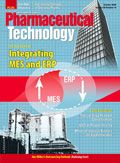A Case for Developing a Standards-Based Approach to Plug-and-Play Equipment
Industry needs a standard to connect systems and equipment sooner rather than later.
The biotech/pharmaceutical industry needs to develop a standards-based hardware and software approach for defining the interface between modern process control systems, vendor-supplied equipment, and "plug-and-play" equipment. Plug-and-play equipment includes chromatography systems, centrifuges, autoclaves, cryogenic systems, and other skid-based process components. A unified standard that connects these systems would not only save time with regard to development, testing, long-term documentation and support of these complex interfaces, but also would reduce vendors' long-term costs by eliminating variations in hardware connections and programming that result from customization between customers.

Scott W. Sommer
A standard for equipment interfaces should maintain diversity and differentiation between vendors' systems and make the integration and maintenance of these systems straightforward and efficient. Such a standard should also address communication protocols, data transfer, and recipe management. The goal would be to provide a flexible, regular interface that significantly reduces the time and effort required to add plug-and-play and other vendor equipment interfaces to the plant's process control system.
The problem
Almost all pharmaceutical, biotech, and biopharmaceutical plants use packaged equipment provided by third party vendors and equipment suppliers. Typically, these skids and packaged equipment are delivered complete, with vendor-supplied process control systems and operator interfaces. Overall, this approach is efficient and cost-effective because the vendor can supply the control-system elements and programming to deliver the required functionality and provide the user with corresponding warranties and performance guarantees.
Regardless of the supplier chosen or the type of system delivered, plant-operations personnel typically desire to include this type of equipment in their main process control systems to monitor and collect data. This inclusion requires an interface to be installed between the plant's process control system (typically a programmable-logic-controller-[PLC] or distributed-control system) and the vendor-supplied equipment (typically a small PLC or microprocessor-based system). Because dozens of possible hardware and software solutions exist, a vendor's process control solution rarely matches that of the strategy employed by the manufacturing site.
Another requirement in many bio/pharmaceutical plants is multipurpose manufacturing using plug-and-play equipment on skids. For example, a portable tank utility panel may perform production preparation, manufacturing operations, and cleaning-in-place (CIP). The utility panel, in this case, is designed to work with portable tanks of different styles, sizes, and functionalities. Some portable tanks may be agitated. Others may have level, pressure, and temperature instrumentation. The plant personnel may desire to roll the plug-and-play equipment up to the utility panel and connect the two for a particular function such as CIP. The process control system will be required to interface with the equipment to perform and monitor each task.
The history
One common scenario is a purification suite where one or more chromatography skid types may be moved into position for a particular product campaign. In this plug-and-play scenario, the process piping, functionality, and operating conditions may be quite different from skid to skid. The process control system needs to not only recognize the type of skid moved into that position but also how to control and monitor the skid.
The solution for connecting the vendor-supplied equipment to the plant's control system nearly always requires custom hardware and software interfaces. These interfaces may or may be difficult to define, develop, install, test, or modify.
For example, if a vendor supplies a controller with a proprietary communications protocol, it may be difficult or impossible to connect that equipment to the plant control system without a special converter box or communications driver. Once installed, this interface may not function correctly if the plant's control system is upgraded in the future.
The interface problem is compounded in the case of plug-and-play equipment packages because a single location now must work with multiple interfaces. As manufacturing space becomes more expensive and the use of disposables and portable equipment grows, standardizing the interface of vendor packages and plug-and-play systems to the plant's control system becomes a critical issue.
The solution
Industry and manufacturing standards and guidelines such as ISA S88, ISA S95, and GAMP5 have helped to streamline the definition, documentation, programming, and testing of process control systems in the bio/pharmaceutical industry. Using these standards allows companies to reduce automation costs from project definition through validation. The last bastion of "customization" in process control continues to be in the interfaces between the process control system and vendor-supplied equipment packages.
The author proposes a single industry standard that addresses:
- Control-system-to-equipment hardware interfaces (e.g., supported protocols and operator interface requirements)
- Data transfer requirements (e.g., data types, packet size, naming conventions, transmission rates, and data format)
- Data storage requirements (e.g., data buffering, storage media, data upload, and data integrity checking)
- Recipe handling (e.g., parameter definition, upload/download, parameter modification, and recipe execution)
- Security and interoperability (e.g., error handling, plug-and-play recognition, initialization, system verification, and watchdog or checksum requirements, etc.)
The author would be pleased to discuss the effort to establish a standards-based approach to plug-and-play pharmaceutical equipment with all interested parties.
Scott W. Sommeris an automationtechnology managerat Jacobs EngineeringGroup,
2 AshStreet, Suite 3000,Conshohocken, PA,19428,scott.sommer@jacobs.com

Drug Solutions Podcast: A Closer Look at mRNA in Oncology and Vaccines
April 30th 2024In this episode fo the Drug Solutions Podcast, etherna’s vice-president of Technology and Innovation, Stefaan De Koker, discusses the merits and challenges of using mRNA as the foundation for therapeutics in oncology as well as for vaccines.
Pharmaceutical Tariffs Are Imminent: How Industry is Bracing for Impact
April 16th 2025On April 14, 2025, the Trump Administration launched a national security-driven investigation into pharmaceuticals, a move that will likely result in tariffs being placed on pharmaceutical drugs, ingredients, and other components that are imported from outside of the United States.